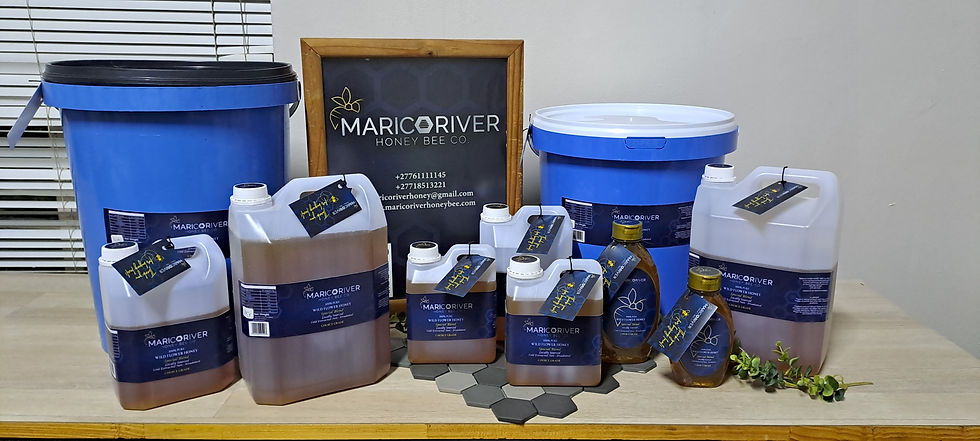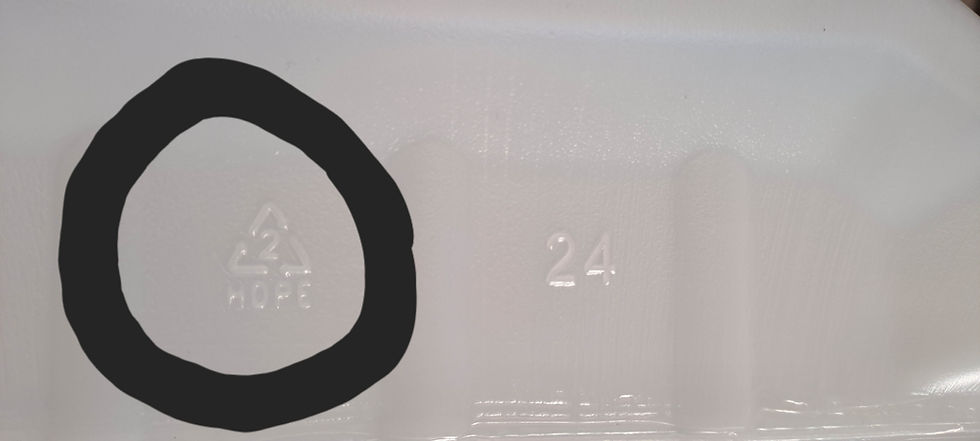Packaging Honey: Why we use plastic - and not glass containers.
- Gerhard Pieters
- May 27
- 4 min read

Honey, often praised as liquid gold, serves not just as a sweetener but also as a powerhouse of health benefits. With a growing focus on sustainability and health, packaging choices for honey are more vital than ever. This post explains why we prefer to use food grade plastic containers, and which ones in particular, and not glass containers for our honey products.
The Role of Packaging in Food Safety
Packaging is key to ensuring honey remains safe and high-quality. It preserves the honey's unique taste and aroma while shielding it from moisture, air, and light, which can degrade its quality over time.
Plastic containers designed for food use are made to ensure safety in food storage by reducing the risk of chemical interactions. On the other hand, glass containers have the inherent benefit of not releasing chemicals into the honey. However, this advantage comes with a higher price, which is ultimately borne by the consumer.
Each style aims to preserve the honey's integrity, making the choice of packaging crucial for producers.
At Marico River Honey Bee Co, we chose to package our honey in food-grade plastic containers. We specifically utilize HDPE (High-density Polyethylene) plastic containers.

This is our reasons for doing so:
Benefits of Food Grade Plastic Containers: HDPE (High -Density Polyethylene)
HDPE Food grade plastic containers bring several distinct advantages that make them appealing to us:
Lightweight and Durable
HDPE food-grade plastic is considerably lighter than glass, which can cut shipping costs by up to 30% and makes products more manageable for consumers. Additionally, the likelihood of breakage is significantly reduced. For example, honey packaged in plastic experiences a lower rate of damage, helping to minimize both costs and waste. Please note that our courier companies do not assume responsibility for any leakage or breakages during shipping, so we must bear these losses ourselves.
Cost-Effective
Plastic containers are generally more wallet-friendly compared to glass. The manufacturing costs for plastic are 40% lower than glass, which means we can offer lower retail prices for our customers.
Versatility in Design
HDPE plastic containers come in various sizes and shapes, offering the flexibility to choose packaging that aligns with our branding. For our larger packaging, we use Easy Pour Jerry Cans, which provide you, our customer, with the advantage of purchasing honey in a container that minimizes wastage during pouring, offering more value for your money.
Chemical Resistance
HDPE resists chemicals, including those found in honey or encountered during storage or transport, preventing leaching or contamination. This ensures you receive uncontaminated, pure, fresh honey every time!
Recyclability
HDPE is a widely recyclable plastic, contributing to a more sustainable packaging solution. Our HDPE Jerry Cans and buckets are also reusable, making it an environmentally friendly choice. By choosing HDPE containers for our honey, we are not only prioritizing your health but also contributing to sustainability efforts. The recyclability and reusability of HDPE helps reduce plastic waste and promotes a circular economy, where materials are reused and repurposed rather than discarded.
Food-Grade Safety
Understanding HDPE Plastic and Its Food Grade Classification
HDPE plastic, or high-density polyethylene, is a widely recognized material known for its durability and safety in various applications, particularly in the food industry.
One of the key attributes of HDPE is its classification as food grade, which means that it meets stringent safety standards set by regulatory bodies. This classification is crucial because it ensures that the materials used in packaging do not leach harmful substances into the food items they contain.
When it comes to packaging honey, the use of food-grade HDPE is particularly significant. Honey is a natural product that is sensitive to contamination. By utilizing HDPE containers, we can guarantee that our honey is stored in a safe environment that maintains its purity and quality.
HDPE is resistant to impact and can withstand a range of temperatures, making it an ideal choice for preserving the delicate properties of honey, which can be affected by exposure to unsuitable materials.
Moreover, HDPE is non-toxic and does not contain harmful chemicals such as BPA (bisphenol A), which can be found in some other types of plastics.
This characteristic further reinforces the safety of our honey packaging, ensuring that consumers can enjoy our product without the worry of chemical exposure. The food-grade classification also means that the material undergoes rigorous testing and meets all necessary health regulations, providing an added layer of confidence for consumers regarding their health and safety.
Larger Quantity Packaging
HDPE Plastic containers and buckets allow us to offer larger quantity products, and for this glass will never be suitable.
The Future of Honey Packaging
When considering packaging for honey, producers must weigh the unique pros and cons of food grade plastic against glass. Factors such as cost, sustainability, aesthetics, and product integrity all come into play.
We recognize that some consumers will consistently favour glass containers, but it's important to remember that not everyone can afford the more expensive honey products in glass. Ultimately, it comes down to personal preference. Additionally, there's a practical aspect to consider: how can we transport large amounts of honey to our commercial clients using glass containers?
In conclusion, the use of food-grade HDPE plastic for packaging our honey is a thoughtful decision that prioritizes both your health and the environment. This material's safety, durability, and recyclability make it an excellent choice for ensuring that our honey reaches you in the best possible condition, free from contaminants and harmful substances.
%20Transparent%20(1).png)



Commentaires